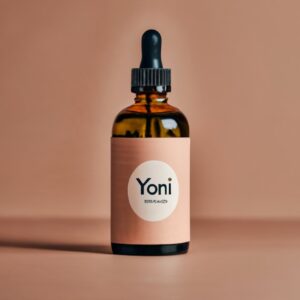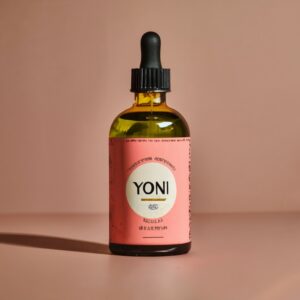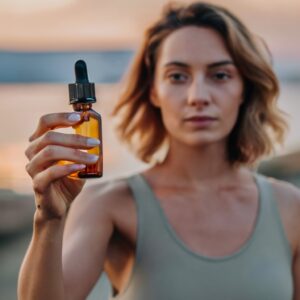
In this blog post, I’m excited to present a DIY yoni oil recipe, crafted with readily available natural ingredients for an enriching and holistic approach to intimate wellness. This blend incorporates a harmonious mix of nourishing base oils, herbs, and essential oils renowned for their abilities to promote the health and balance of the vaginal area.
WHAT IS A YONI OIL?
Yoni oil, alternatively referred to as vaginal oil, represents a carefully crafted natural fusion of oils enriched with essential oils and herbs. Specifically formulated to promote feminine hygiene and enhance vaginal self-care, yoni oil stands as a holistic approach to nurturing and maintaining the well-being of the intimate area. Crafted with precision, this blend aims to provide a soothing and supportive experience, acknowledging the delicate balance required for feminine hygiene. Embracing the goodness of essential oils and herbs, yoni oil is designed to be a gentle and natural addition to your self-care routine, fostering a sense of overall comfort and confidence.
WHAT ARE THE BENEFITS OF YONI OIL?

The benefits of yoni oil span a range of advantages tailored to enhance the well-being of the vaginal area. Depending on the specific ingredients used in the recipe, here are notable benefits that one can expect:
Improvement in Skin Health:
Yoni oils are designed to alleviate dryness, itching, and irritation, promoting an overall state of health and balance for the skin around the vaginal area.
Prevention of Ingrown Hair:
The moisturizing oils in yoni oil maintain skin hydration, allowing hair to penetrate the surface easily. Simultaneously, antimicrobial agents like tea tree oil help eliminate bacteria and fungus, reducing inflammation. This combined action prevents new ingrown hairs, aids in the healing of existing ones, and guards against infection.
Antimicrobial and Anti-fungal Properties:
Essential oils such as tea tree oil and oregano oil present in yoni oil contribute powerful antifungal properties, effectively combating and preventing fungal infections in the vaginal area.
Odor Improvement:
Yoni oil formulations, featuring tea tree oil as a natural antimicrobial agent, work to curb the growth of bacteria and yeast responsible for unpleasant odors. Additionally, the inclusion of neroli and sweet orange essential oils imparts a pleasant and feminine fragrance, collectively leaving you feeling fresh and clean.
INGREDIENTS FOR HOMEMADE YONI OIL
Calendula Infused Oil:
Calendula oil emerges as an excellent choice for intimate care, offering soothing properties to calm irritated skin and reduce inflammation. Particularly beneficial for individuals dealing with conditions like eczema and dermatitis, Calendula’s natural healing attributes make it effective in aiding the recovery of minor cuts and irritations in sensitive areas. Moreover, its moisturizing qualities contribute to keeping the intimate area hydrated.
MCT Oil:
MCT oil, derived from coconut oil, is a unique addition to this blend. Comprising medium-chain triglycerides (MCTs) with the removal of lauric acid, it remains liquid at room temperature. Noteworthy for its potent anti-fungal properties, MCT oil combats common fungi like Malassezia and Candida. This makes it an effective solution for various skin issues linked to fungal presence, including folliculitis, psoriasis, dandruff, and seborrheic dermatitis. The oil’s composition, rich in caprylic acid, acts against fungi, starving them and impeding their growth. Additionally, MCT oil feels lightweight and non-greasy, ensuring a pleasant user experience.
Can I use coconut oil instead of MCT oil?
While coconut oil is an option, it lacks the same antifungal properties as MCT oil due to the presence of lauric acid. Given the susceptibility of vaginal skin to fungal issues, MCT oil is recommended for optimal benefits.
Bisabolol:
Derived from Roman chamomile, Bisabolol takes center stage with its anti-inflammatory and antibacterial properties. It accelerates the healing process and provides relief to irritated and sensitive skin. Particularly recommended for sensitive, allergic, and psoriasis-prone skin, Bisabolol adds a calming touch to this formulation.
Tea Tree Oil:
Tea tree oil plays a multifaceted role in this recipe. As a yoni oil ingredient, it serves as a preventive measure against infections and folliculitis by eliminating harmful bacteria and fungi. Its anti-inflammatory properties contribute to reducing swelling, itching, and redness, especially after shaving. Furthermore, tea tree oil aids in the faster healing of wounds, cuts, and ingrown hair, showcasing its powerful properties backed by scientific research.
Vitamin E:
Vitamin E oil, a renowned antioxidant and anti-aging component, enhances the overall efficacy of the formulation. Beyond boosting antioxidant properties, it extends the shelf life of the oils, ensuring a longer period of use for this meticulously crafted blend. Incorporating Vitamin E adds a layer of protection and anti-aging benefits to your intimate care routine.
YONI OIL RECIPE

Yoni Oil Recipe for a 50 ml Bottle:
Ingredients:
- 20 ml Calendula Infused Oil
28 ml MCT Oil
0.3 ml (approx. 5 drops) Bisabolol (up to 1% of formula)
3 drops Vitamin E
5 drops Tea Tree Oil
7 drops Neroli Oil
4 drops Sweet Orange Oil
Instructions:
Calendula Infused Oil (20 ml):
Begin by measuring and adding 20 ml of Calendula Infused Oil to the 50 ml bottle. This base oil brings soothing and anti-inflammatory properties to the blend.
MCT Oil (28 ml):
Pour 28 ml of MCT Oil into the bottle. This unique oil with anti-fungal properties remains in liquid form at room temperature, contributing to the formula’s effectiveness.
Bisabolol (0.3 ml):
Carefully add approximately 5 drops of Bisabolol, ensuring it does not exceed 1% of the total formula. This ingredient offers anti-inflammatory and antibacterial benefits.
Vitamin E (3 drops):
Include 3 drops of Vitamin E oil to enhance the antioxidant properties and extend the shelf life of the yoni oil.
Tea Tree Oil (5 drops):
Incorporate 5 drops of Tea Tree Oil, known for its antimicrobial and anti-inflammatory attributes, providing preventive care against infections.
Neroli Oil (7 drops):
Add 7 drops of Neroli Oil to the mix. This essential oil not only contributes a pleasant fragrance but also provides additional benefits for the skin.
Sweet Orange Oil (4 drops):
Finally, include 4 drops of Sweet Orange Oil for a delightful and feminine aroma. This essential oil adds a refreshing touch to the overall blend.
Note:
Be cautious with essential oil quantities, as excessive use may lead to skin irritation, particularly for those with sensitive skin.
The total drops of essential oils in this recipe (Tea Tree Oil, Neroli Oil, Sweet Orange Oil) do not exceed the recommended limit of 20 drops for a 50 ml bottle, ensuring a balanced and gentle formulation.
HOW TO MAKE YONI OIL

Yoni Oil Preparation:
Cook Time: 15 minutes
Total Time: 15 minutes
Instructions:
Prepare the Aesthetic Base (Optional):
Begin by adding a small quantity of dried calendula petals to your bottle for visual appeal. This step is purely for aesthetic purposes and can be skipped if desired. If using dried Calendula with whole flowers, select vibrant yellow petals for an aesthetically pleasing appearance inside the bottle.
Note: If you’ve chosen dried Calendula with whole flowers, ensure to carefully select bright yellow petals for visual appeal.
Pour Calendula Oil:
If you’ve infused the oil yourself, strain it first using cheesecloth to remove any flower residue. Skip this step if you’re using pre-made calendula oil. Use a small funnel to pour calendula oil into the bottle, filling it to just less than half capacity.
Add MCT Oil:
Pour MCT oil into the bottle, leaving a small amount of space at the top for the addition of essential oils, Vitamin E, and Bisabolol.
Incorporate Essential Oils and Additional Ingredients:
Add the specified drops of Tea Tree Oil, Neroli Oil, Sweet Orange Oil, Vitamin E, and Bisabolol. Ensure accurate measurements to maintain the balance of the formula.
Close and Shake Well:
Seal the bottle tightly and shake it well to thoroughly combine all the ingredients. This step ensures a homogeneous blend of the oils and other components.
Final Touch:
Your yoni oil is now ready for use. Store it in a cool, dry place, and shake gently before each use to ensure the ingredients are evenly distributed.
This simple and quick process results in a carefully crafted yoni oil, ready to enhance your self-care routine with its natural and beneficial properties.
DIY Yoni Oil Customization Ideas and Ingredients Table:
| Customization Ideas | Ingredients to Add |
|---|---|
| 1. Sensitive Skin Blend | – Chamomile Infused Oil |
| – Lavender Essential Oil | |
| – Jojoba Oil | |
| ————————— | ————————— |
| 2. Relaxation Formula | – Lavender Essential Oil |
| – Ylang Ylang Essential Oil | |
| – Coconut Oil (fractionated) | |
| ————————— | ————————— |
| 3. Energizing Blend | – Peppermint Essential Oil |
| – Eucalyptus Essential Oil | |
| – Almond Oil | |
| ————————— | ————————— |
| 4. Skin Brightening Mix | – Rosehip Seed Oil |
| – Geranium Essential Oil | |
| – Lemon Essential Oil | |
| ————————— | ————————— |
| 5. Healing and Soothing | – Calendula Infused Oil |
| – Frankincense Essential Oil | |
| – Argan Oil | |
| ————————— | ————————— |
HOW TO use YONI OIL

Usage Recommendations for DIY Yoni Oil:
For optimal results, incorporate your DIY yoni oil into your daily routine, especially after showering. Follow these steps to maximize its benefits:
Post-Shower Application:
After showering, take a couple of drops of your DIY yoni oil and rub it between your palms. Gently apply the oil to moisturize the mons pubis and labia. This routine can contribute to overall skin health and hydration.
After Waxing or Shaving:
Using the yoni oil becomes particularly beneficial after waxing or shaving the vaginal area. Apply the oil to soothe sensitive skin and prevent the development of ingrown hairs. The moisturizing and anti-inflammatory properties of the oil can provide comfort and support during the post-hair removal period.
By incorporating your DIY yoni oil into your daily care routine, you can enjoy its natural and nourishing benefits, promoting the well-being of the intimate area.
What are side effects of using yoni?
While many people use yoni oil without experiencing adverse effects, it’s important to be aware that individuals may react differently to certain ingredients. Here are potential side effects to consider:
- Skin Irritation: Some individuals may be sensitive or allergic to certain oils or essential oils present in yoni oil, leading to skin irritation, redness, or itching.
- Allergic Reactions: Allergic reactions can occur if you are allergic to any of the ingredients. It’s essential to perform a patch test before widespread use to check for allergies.
- Disruption of Vaginal pH: Some formulations might disrupt the natural pH balance of the vagina, leading to discomfort, increased susceptibility to infections, or other vaginal health issues.
- Infection Risk: If the yoni oil is contaminated or not stored properly, it may carry the risk of bacterial contamination, which could lead to infections.
To minimize the risk of side effects:
- Patch Test: Before applying yoni oil to a larger area, perform a patch test on a small part of your skin to check for any adverse reactions.
- Choose High-Quality Ingredients: Opt for high-quality, organic, and natural ingredients to reduce the likelihood of irritation or allergies.
- Avoid Fragrances: Some individuals may be sensitive to fragrances, so it might be beneficial to choose fragrance-free or lightly scented options.
- Consult a Professional: If you have any concerns or pre-existing conditions, consult with a healthcare professional before using yoni oil.
FAQ’S
What are yoni oils used for?
Yoni oils are designed for intimate care, aiming to support the overall health and well-being of the vaginal area. They are often used for moisturizing, soothing irritation, and promoting a balanced environment.
Does Yoni oil help with smell?
Yes, some yoni oils are formulated with ingredients like tea tree oil, known for its antimicrobial properties, which can help combat bacteria and yeast growth, potentially addressing unpleasant odors.
Does Yoni oil tighten?
Certain formulations claim to have ingredients that may contribute to a temporary tightening sensation. However, it’s essential to approach such claims with caution and be aware that individual experiences may vary.
What is Goddess Yoni oil for?
“Goddess Yoni oil” is a term used for a type of yoni oil that often includes a blend of luxurious and nourishing oils along with botanical extracts. It is intended to provide a holistic and pampering experience for intimate self-care.
What is the power of the yoni?
In various spiritual and holistic practices, the term “yoni” symbolizes the divine feminine energy and the creative power of the female reproductive system. The power of the yoni is often associated with creativity, sensuality, and life force.
Can you eat yoni oil?
No, yoni oil is not intended for internal consumption. It is formulated for external use on the skin in the intimate area. Ingesting yoni oil could lead to adverse effects due to the presence of essential oils and other concentrated ingredients.
What is yoni oil made of?
Yoni oil formulations can vary, but they typically consist of a base oil (like coconut or almond oil), essential oils (such as tea tree or lavender), and additional ingredients like herbs (calendula, chamomile) for their soothing properties.
How many drops of yoni oil?
The number of drops of yoni oil to use can depend on personal preference and the specific formulation. As a general guideline, it’s recommended to use a small amount, typically a few drops, and not exceed the recommended usage to avoid potential irritation. Always follow the instructions provided by the product or formulation.
